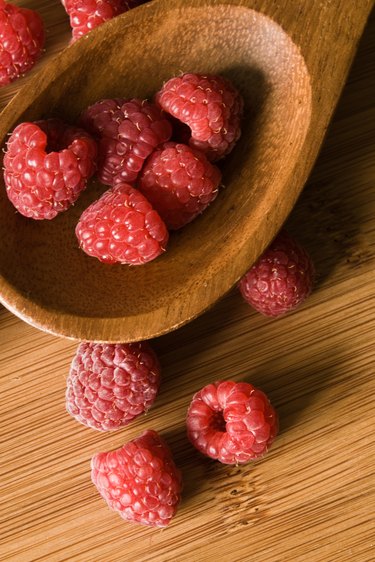
A summertime fresh fruit favorite, red raspberries result from the pollination of the five-petaled white flowers on the thorny plant known botanically as Rubus idaeus. Although this species is native to both North America and western Asia, the modern red raspberry plant arose from centuries of cultivation in Europe. The British introduced improved garden raspberry plants to North America in 1771 through the American colony of New York. Raspberries need a cold winter climate, not a warm, tropical environment, to prosper.
Climate Characteristics
Video of the Day
Red raspberries are best grown in regions with cold winters and cool summers. The winters must be amply cold to ensure the biological process of vernalization occurs, which is the requirement for exposure to enough chill for flowers to form in spring. Ideally, the transition from winter to summer is a slow, gradual warm-up so the raspberry plants experience a cool but comfortable temperature regimen. Not enough winter cold occurs in tropical regions for red raspberry plants to survive for long, and certainly not to cause flowering. Even in the milder winter areas of the temperate Southern United States, raspberries are not a reliable crop.
Video of the Day
Vernalization
Only in the highest elevations in the tropics, where winters are adequately chilly, might red raspberries grow well. For raspberry plants to be vernalized over the winter dormancy, enough exposure to temperatures between 32 and 45 degrees Fahrenheit must occur. This exposure is measured in chilling hours. Between 800 and 1,600 chilling hours are needed for raspberries to vernalize and subsequently bloom and fruit the following spring. Through extensive breeding efforts, some cultivars of raspberries may need only 250 chilling hours, such as with cultivar Heritage.
Growing Regions
Red raspberries are grown across the temperate parts of the world, not in tropical or subtropical areas. In the United States, gardeners in U.S. Department of Agriculture plant hardiness zones 4 through 8a grow raspberries. In these zones, the winter temperatures drop into the 20 to minus 25 degrees Fahrenheit range. Then in summer, no more than 100 days of temperatures above 86 F occur annually, which correlates to American Horticultural Society heat-zones 8 through 4.
World Production
The vast majority of raspberry production occurs in Europe and North America, according to 2008 production data -- the most recent available at publication -- from the Food and Agriculture Institute of the United Nations. Russia, Serbia, Poland, the United States and Ukraine are the top five producers in descending order. The top 10 list ends with the United Kingdom, Canada, Mexico, Spain and Azerbaijan. The next 10 leading producing nations are overwhelmingly European.